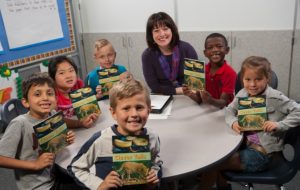In today’s educational milieu, various versions of guided reading exist. Most versions offer three components: an introduction before reading, reading and discussing during the lesson, and some options to extend learning after reading the text. Each variation rationalizes the methods and techniques offered on their templates. But rather than filling in boxes on templates and “doing” guided reading, effective teachers must consider the purposes of and outcomes for using guided reading as they support students to make meaning from texts.
Guided Reading lies alongside independent reading in a gradual model of release model, with opportunities arising throughout lessons for applying known reading strategies to make meaning of a text. Before meeting with the students, the teacher is fully responsible for forming groups, determining instructional focuses, selecting texts, and planning lessons. However, once the lesson begins, the teacher relinquishes the roles of meaning-maker and problem-solver. When teachers hold the book for picture walks, tell students the gist of a story, or work through problems anticipated within the text before students read the text, teachers squander opportunities for students to be responsible meaning-makers. Guided Reading is “students, with the support of the teacher, reading, thinking, and talking their way purposefully through a text” (Reading in Junior Classes, 1991).
How might this look when students take responsibility for their own meaning-making in a Guided Reading lesson?
Before reading
During introductions, teachers position students to make meaning of the text for themselves. For early emergent and emergent readers (those reading in levels A-C texts), children assume responsibility as they handle their own books in a teacher-guided book walk. Students, with a teacher’s guidance, build storylines or information-lines of thinking as they interact with both the pictures and words. In a guided reading book introduction, teachers intentionally integrate language patterns and vocabulary within the discussion to activate semantic and syntactic cueing systems for students. These meaning- and language-based scaffolds assist these novice readers for whom the graphophonic system is just beginning to emerge as a support. However, even in these beginning stages of reading, observant teachers step back as students demonstrate more ownership and responsibility for independently making meaning of the text.
And, with early stages of reading development and beyond, readers introduce books to themselves with the teacher alongside to support, rather than lead, this book exploration. This handing over of responsibility means students make meaning of a text for themselves under the watchful eye of their teacher.
During reading
While thoughtful teachers may indicate a section of text to be read before stopping for discussion, students read and think independently and with the other group members during guided reading as they make meaning of the text. The teacher launches discussion with a broad question, such as ‘what are you thinking?’ supporting students to take responsibility for their individual contributions to the group’s co-constructed meaning. Probing student responses with ‘say more about that’ and ‘what in the text got you thinking about that?’ facilitates students to expand and clarify their own thinking for themselves and others. Teachers benefit from this key assessment moment to notice what in the text children attend to and what they ignore. Throughout this student-led discussion, the teacher layers in more pointed, text-dependent questions, directing readers to important and perhaps unnoticed aspects of the text. The purpose of this discussion is for students to make meaning of the text.
After reading
To close the Guided Reading lesson, teachers notice—and name—effective and strategic thinking and actions demonstrated by students as they made meaning of the text. Peter Johnston (2012) calls this “causal process feedback” when teachers notice and name strategic actions that have occurred and link these student actions to specific outcomes. These observations may lead to relevant discussions of challenges in the text and how students solved them or how students used the text or the other learners to make meaning. Through these relevant experiences, students develop an agency. And, if challenges occurred and students didn’t solve them, teachers possess relevant examples and experiences to illustrate teaching students the need for their learning. Margaret Mooney reminds us that at all times, the “teacher’s decision-making is driven by what children need for their learning rather than what children need to learn.”
Try doing less of the thinking and reading during a guided reading lesson. Offer students responsibility for making meaning of the text—they may surprise you! Debra Crouch.


